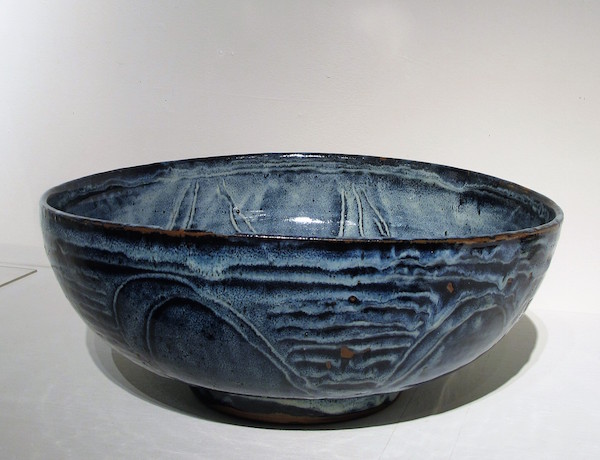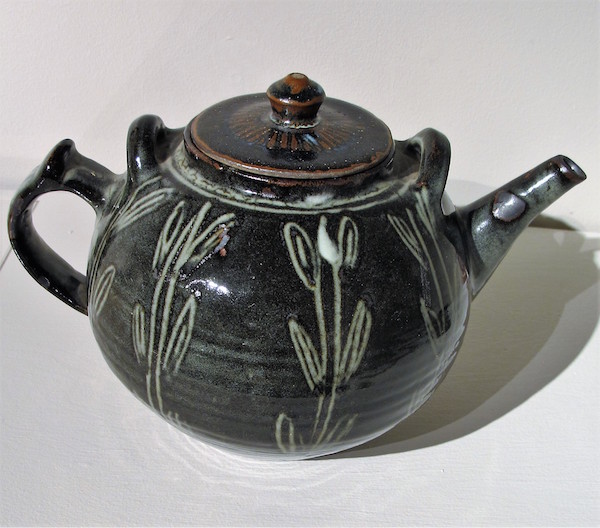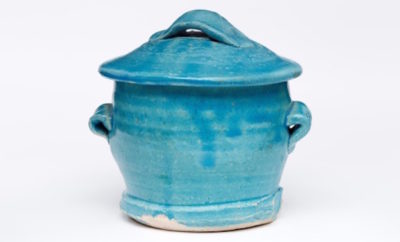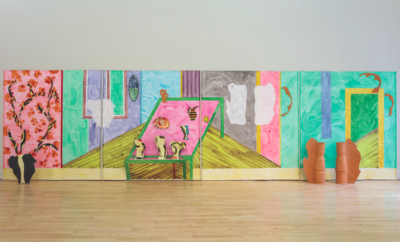 All photography courtesy the Estate of Afi Ekong, Nigeria and Skoto Gallery, New York.
All photography courtesy the Estate of Afi Ekong, Nigeria and Skoto Gallery, New York.
Exhibition
Tradition and Imagination: The Remarkable Pottery of Ladi Kwali at the Skoto Gallery
A small show of robust work at the Skoto Gallery in New York honors Ladi Kwali, the Gwari potter, who became famous in the 1960s and early 1970s when she demonstrated her craft in England, Germany, and North America, introduced and accompanied by the British studio potter Michael Cardew. The exhibition includes a collection of Nigerian-born Kwali’s sturdy tableware—cups and saucers, dishes, bowls, beakers, an urn and a teapot—as well as her large traditional water pot with imaginatively incised zoomorphic figures. The invitation to the exhibition shows a glazed stoneware plate she made in 1963 that the gallery has appropriately entitled What Comes Around. The modest piece, little more than four inches across in diameter, was built on a potter’s wheel like the ones used in English studios at the time, but ornamented with exuberant loops and zigzags that were part of Kwali’s particular graphic lexicon. It gets to the heart of the story, demonstrating how a simple object can close the circle, bridging the gap between cultural traditions while also merging folk art with her own exceptional talent.

Punch Bowl by Ladi Kwali, c. 1960. Glazed stoneware.
Ladi Kwali (Ladi, meaning “born on Sunday,” and Kwali, the name of the village in the northern region of Nigeria where she was born in 1925) learned to make hand-built pots when she was a small child. It was the practice for women in the area to make pots from clay dug out of the ground: pulling up the sides of the clay, stretching them up and across, then scraping them down, adding coils, shaping and smoothing the pieces with cloth or leather. The technique was passed down through generations of families, from one female member to another. Kwali learned from her aunt but she was quickly recognized for her innate talent, showing an understanding of balance and proportionality as well as the material possibilities of clay. She incised her pots with geometric and symbolic designs of energetic reptiles, fish, or birds that sometimes stand on top of one another in strips that encircle her vessels. As is the case with most authentic artistry, you can identify her hand.

Bowl with cover by Ladi Kwali, c. 1960s. Glazed stoneware.
When Cardew came to Abuja to establish his Pottery Training Center he saw a collection of her pots in the house of the emir and soon invited her to become part of his project. He was working for the colonial office and tasked with developing a ceramic industry in Nigeria, using the methods of British studio pottery. By bringing in a star like Ladi Kwali, he hoped to link the region’s traditional craft to what he called his “scheme” to grow the local economy. The stoneware produced at Abuja was intended to be marketed within Nigeria as an inexpensive and utilitarian merchandise, an idealistic enterprise that unfortunately never achieved its financial goal.

Tea pot by Ladi Kwali, c. 1960s. Glazed stoneware.
In the Abuja workshop, Kwali continued to make traditional pots and, under Cardew’s supervision, she also began to throw on the wheel, using glazes, and baking in a kiln. The useful stoneware objects in the exhibit, though somewhat wobbly, show Cardew’s influence on Kwali. You can see this in her covered jar with its bowed handle and well-made lid, or her tightly formed urn that was likely modeled on a lovely, compact urn by Cardew that’s also included in the show. At the same time, the freedom in her decorative details—the sprigs on her teapot or the circles, arcs, and crosshatching on a plate—demonstrates the expressive touch of her hand as well as her buoyant personality. The most prized item in the exhibit, a heavy water vessel, over a foot tall and just about equally broad, is a hybrid work, hand-built and coiled in customary Gwari fashion but made from stoneware and decorated with sgraffito scratched into white slip. The ornament—the fish scales and rouletted bands that Kwali drew vividly and with exceptional grace—stands out all the more because of the heavy glaze. In this way, the technique borrowed from British studio pottery enhanced what Cardew called “the expression of a people’s genius.”












